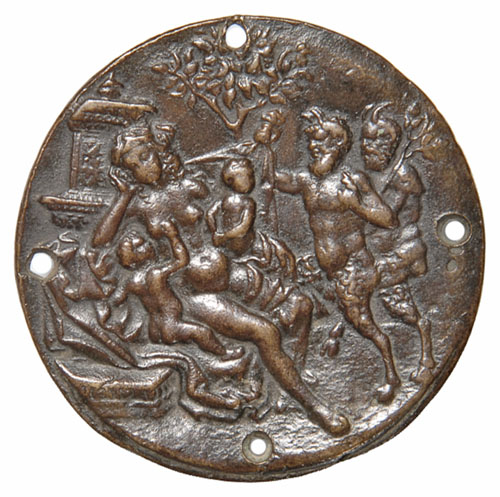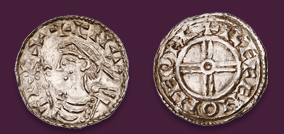
Auction: 8004 - An Important Collection of Renaissance Medals & Plaquettes
Lot: 13
Pseudo Antonio da Brescia Two Satyrs discovering a Sleeping Nymph, circular bronze plaquette, 58mm., a very fine old cast with medium brown patina, pierced at the four cardinal points, two areas of solder on the reverse A nymph, naked except for drapery over her left leg, reclining at an altar inscribed VIRTVS, resting her head on her right hand, two children at her sides, is approached by two satyrs, one lifting the drapery, the other carrying a branch The composition probably derives from an ancient gem, possibly a cameo. The satyr lifting the drapery is seen on several gems, for example the agate in the collection of Cardinal Pietro Ottoboni, published by Maffei (plate 9), and also the cornelian in the Vienna Kunsthistorisches Museum (Zwielrlein-Diehl 240). The scene is reproduced in the Hypnerotomachia Poliphili of Francesco Colonna, printed in Venice in 1499 - p.73. It is found in the cloister of St. Martin of Tours (early 16th century), in the castello at Villers-Cotterets, in a house in Valence, and on a Nuremburg cup in the museum at Budapest. It is engraved by Benedetto Montagna (Hind, E.I.E. pl.747; Passavant 50). A variant without the inscription is in Vienna, and it occurs as a sword pommel (Brescia 11 and Louvre 310), and in pentagonal form (Brescia 12). See also the base of a candelabra in the Figdor collection (Bode, 1912, II, fig.CXXXI). References Bange 1922, 654; Cannata 37; Cott p.149; Florence, Bargello 94 and Carrand 449-450 (as G.F.Bonzagni); Kress 189 (reverse); London, British Museum, T.W. Greene, 285; Molinier 122; Maclagan p.57 (two examples); Middeldorf, Morgenroth, no.266; Migeon, in Les Arts, no.80, August 1908, p.23; Paris, Louvre, 292; Planiscig 1919, 373; Planiscig 1924, 400 (both as North Italian, early 16th century, circle of Riccio); Ricci, ii, pp.83-84; no.118; Rizzini 10; Rizzoli 32-33 Estimate £ 300-500
Sold for
£200




